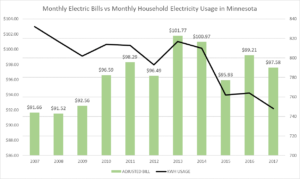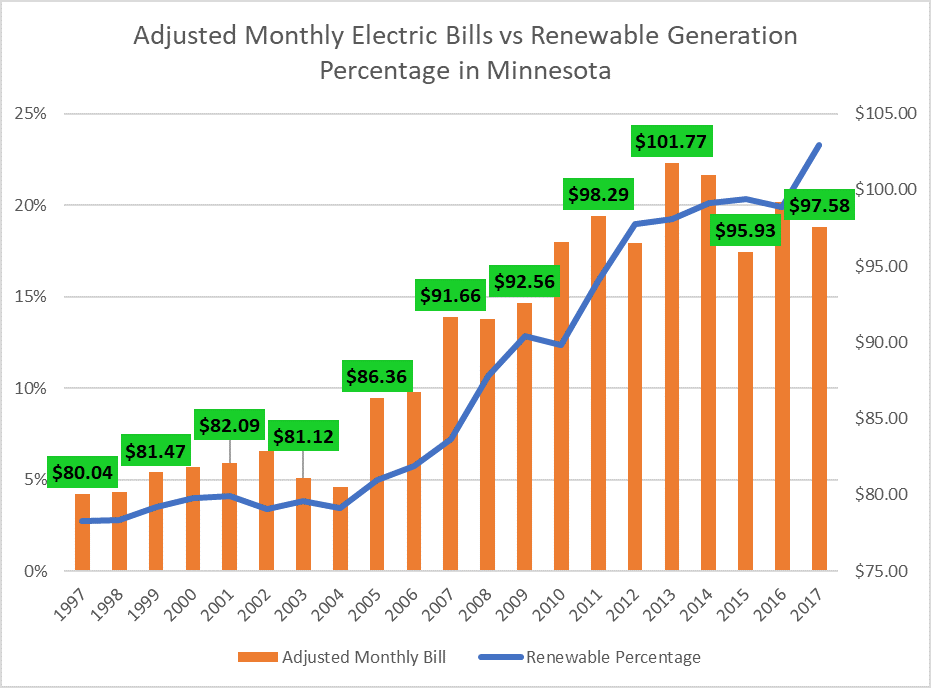Fresh Energy Is Still Intentionally Misleading Minnesotans on Energy Issues: Part Six – How Decoupling Will Make Things Worse For Ratepayers
Fresh Energy, a renewable energy advocacy organization, continues to mislead Minnesotan’s on energy issues – and it appears they don’t appreciate our work explaining how wind and solar are driving up the cost of electricity in our state.
In their latest critique of American Experiment, Fresh Energy made multiple attempts to inaccurately portray our organization as misunderstanding how electric rates work, while arguing that wind and solar are the cheapest sources of electricity in our state and a boon to job creation.
Each of these claims is demonstrably false.
The article below is the sixth in a series of articles that will thoroughly explain how Fresh Energy continues to mislead Minnesotan’s on the cost of electricity in our state.
How Decoupling Will Make Things Worse For Ratepayers
If you use less electricity, you should pay less on your electric bill. Right?
Unfortunately, in Minnesota, that’s not the case, as electricity bills have increased by 8 percent even though we consume 10 percent less electricity than we did in 2007, and it will only get worse if “decoupling” becomes standard policy.

For those of you unfamiliar with the term decoupling, renewable energy advocacy groups, like Fresh Energy, are advertising it as a way of severing the tie between electricity sales and the amount of revenue electric utility companies earn. As Fresh Energy states:
“Revenue decoupling breaks the link between a utility’s energy sales and the revenue it collects to cover the costs of providing service. Without decoupling, a utility’s revenue is dependent on the amount of energy it sells, creating an incentive for investor-owned utilities—which make a profit for shareholders—to sell more energy and resist efforts to drive energy efficiency. With decoupling, a utility’s revenue is no longer dependent on the amount of energy it sells, removing the disincentive to encourage customers to use less.”
Under decoupling, utilities, with the approval of the Minnesota Public Utilities Commission (PUC), will determine a suitable revenue that they will be allowed to earn in given a year. If sales are too high for a month and revenues exceed the determined amount, ratepayers will receive a refund. However, if Minnesota electricity users conserve too much electricity and utilities don’t sell enough electricity to cover the determined revenue amount, utilities will simply be allowed to charge ratepayers more money to make up the difference.
If you read part four of this series, then you already know that this is essentially how it works already – the only difference being that when utilities experience a revenue deficiency one year, they need to file “rate cases” to increase electricity rates in later years to recover their losses.
In this way, energy efficiency simply won’t save you any money while electric utility companies continue to increase the amount of revenue they need to recover from consumers. Energy efficiency merely reduces the amount of electricity sales that are made. If utilities need to recover the same or greater amount of revenue regardless of your efforts to conserve electricity, then energy efficiency only leads utilities to request rate increases to cover their loss in revenue, as they have done in the past and will continue to do.
This means higher electricity rates and no savings in electric bills – and utilities always win and ratepayers always lose. Unfortunately, this is exactly what is happening in Minnesota.
Utilities in our state have been forced to spend enormous sums of money on inefficient and intermittent renewable energy sources, despite electricity demand remaining essentially flat for more than 10 years.
This has led to a substantial increase in the amount of revenue utilities need to recover through ratepayers, despite electricity sales flattening, because investing in renewable energy sources results in utilities taking on more fixed expenses – such as the capital costs for constructing new facilities – as opposed to variable costs – such as fuel expenses, which wind and solar energy sources do not require.
And when utilities are deciding on the electricity rates they are going to charge their customers and have a lot of fixed capital expenses to pay off, the revenue they will need to recover through ratepayers will also be a larger fixed amount – meaning that, regardless of how much electricity consumers use, utilities will need to recover the same amount or more from them.
This can be seen in the graph below. Even though electricity sales in Minnesota has grown by only 3 percent since 2004, utility revenues have increased by over 30 percent in inflation-adjusted dollars.

Revenues are rising so dramatically because utilities have been required to invest over $15 billion already on expensive renewable energy sources that need to be paid for regardless of electricity sales.
As the graph below shows, this is exactly why electric bills in Minnesota have increased by over 20 percent since 2004, in inflation adjusted dollars, when Xcel Energy became the first utility in the state mandated by law to incorporate more renewable energy sources in their portfolio and total renewable energy generation grew over 5 percent.

Contrarily, on a system dependent on fuel-based electricity generators – most of which operate past their depreciation lives, meaning they no longer have capital expense to pay off – if electricity ratepayers use less electricity, utilities will also spend less on fuel, resulting in lower electric bills for Minnesota ratepayers.
Unfortunately, because renewable energy mandates are only increasing in Minnesota, utility companies are only being forced to invest even more money to incorporate intermittent wind and solar energy sources onto the electrical grid.
This is why “decoupling” is now being pushed by renewable energy advocates, like Fresh Energy.
In doing so, Fresh Energy is actually reducing any incentive ratepayers may have to decrease electricity usage in the hopes of lowering their monthly electric bills because rising electricity prices will swallow up the savings. This also enables utilities to continue their reckless spending on renewable energy sources in the face of decreasing electricity sales, ensuring they always receive the revenue required to fulfill the costly renewable energy mandates imposed on them.
It’s advocating for the house (monopoly utility companies) to always win.
Decoupling Is a Win for Utility Profits
Renewable energy advocates, seemingly tired of seeing utility companies file rate case after rate case to increase electricity prices to cover their spending on renewable energy additions, seek “decoupling” as a way of streamlining the process of charging you more for their failed renewable energy policies.
On its face, “decoupling” makes it seem like ratepayers may even benefit by the possibility of receiving a refund on their electricity bills.
However, this is only until you realize that receiving a refund is highly unlikely, considering that electricity sales are still relatively flat, more energy conservation initiatives are taking place attempting to decrease sales even further, and revenue requirements for utilities are still increasing due to renewable energy mandates forcing them to invest in new power facilities, even though electricity demand doesn’t require it.
Lower Electricity Sales + Higher Revenue Requirements = Higher Electric Bills for Minnesota ratepayers.
If Minnesotan’s care about having low electricity costs, then they should reject decoupling and start holding electricity regulators and utilities accountable for the irresponsible investments they have made in renewable energy sources, which is a primary reason electric bills have increased so substantially in recent years.